Trans-Pacific Partnership: Impact on Australian Businesses Analysis
VerifiedAdded on 2021/05/30
|9
|2158
|36
Report
AI Summary
This report provides a comprehensive analysis of the Trans-Pacific Partnership (TPP) and its effects on Australian businesses. It begins by defining global strategic management and the TPP, including its member countries and objectives. The report then explores the opportunities presented to Australian businesses, such as new market creation, export expansion for small businesses, employment generation, reduced trade restrictions and taxes, promotion of the digital economy, and increased GDP and GNP. Furthermore, it discusses the advantages Australia gains through investment opportunities and access to investor-state dispute settlements. The report also addresses the major trade-offs, including potential exploitation by some member countries, the impact of the US withdrawal, and challenges related to domestic drug production and employment. The conclusion summarizes the positive and negative impacts, emphasizing that the benefits of the TPP outweigh the drawbacks for Australian businesses. The report references several academic sources to support its findings.
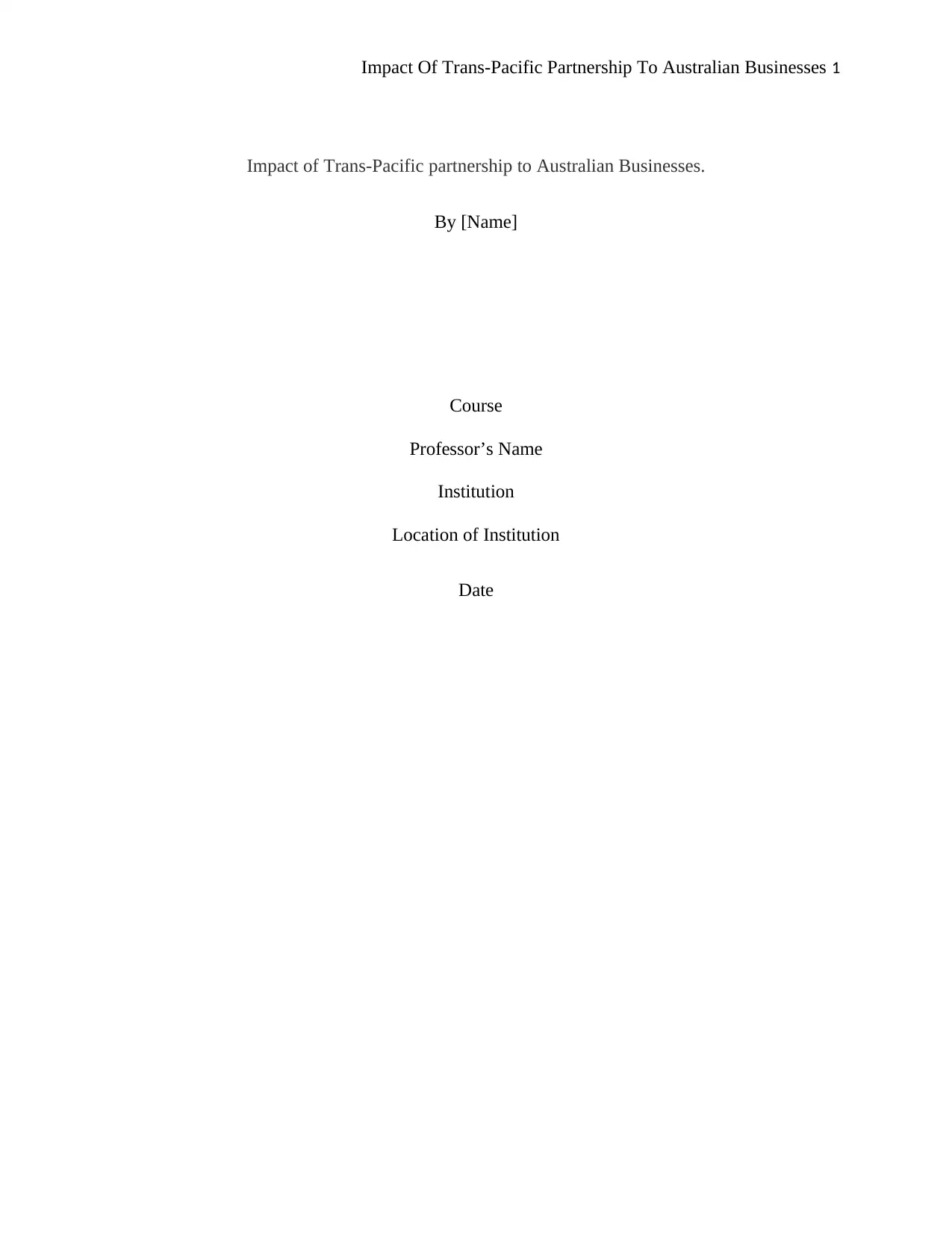
Impact Of Trans-Pacific Partnership To Australian Businesses 1
Impact of Trans-Pacific partnership to Australian Businesses.
By [Name]
Course
Professor’s Name
Institution
Location of Institution
Date
Impact of Trans-Pacific partnership to Australian Businesses.
By [Name]
Course
Professor’s Name
Institution
Location of Institution
Date
Paraphrase This Document
Need a fresh take? Get an instant paraphrase of this document with our AI Paraphraser
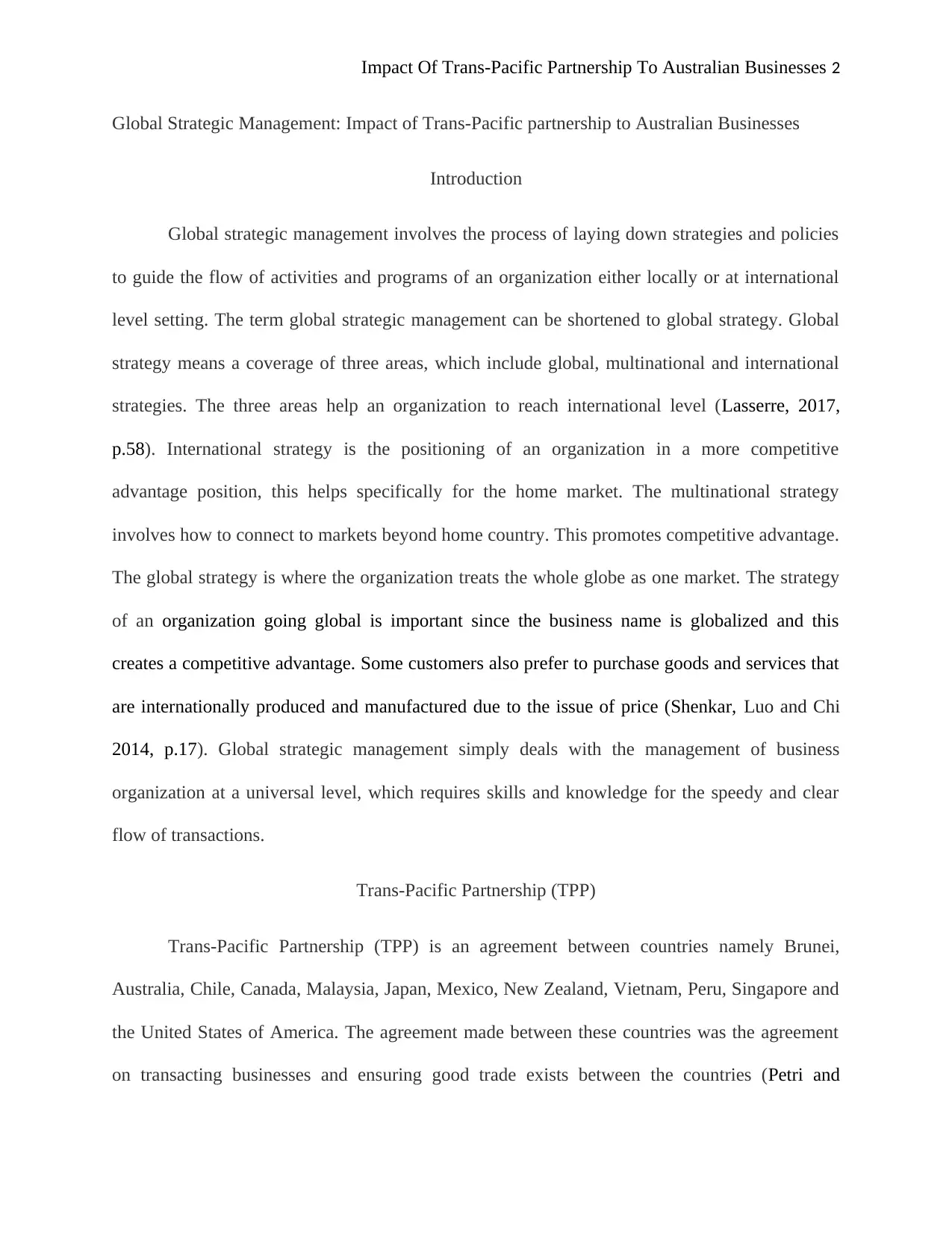
Impact Of Trans-Pacific Partnership To Australian Businesses 2
Global Strategic Management: Impact of Trans-Pacific partnership to Australian Businesses
Introduction
Global strategic management involves the process of laying down strategies and policies
to guide the flow of activities and programs of an organization either locally or at international
level setting. The term global strategic management can be shortened to global strategy. Global
strategy means a coverage of three areas, which include global, multinational and international
strategies. The three areas help an organization to reach international level (Lasserre, 2017,
p.58). International strategy is the positioning of an organization in a more competitive
advantage position, this helps specifically for the home market. The multinational strategy
involves how to connect to markets beyond home country. This promotes competitive advantage.
The global strategy is where the organization treats the whole globe as one market. The strategy
of an organization going global is important since the business name is globalized and this
creates a competitive advantage. Some customers also prefer to purchase goods and services that
are internationally produced and manufactured due to the issue of price (Shenkar, Luo and Chi
2014, p.17). Global strategic management simply deals with the management of business
organization at a universal level, which requires skills and knowledge for the speedy and clear
flow of transactions.
Trans-Pacific Partnership (TPP)
Trans-Pacific Partnership (TPP) is an agreement between countries namely Brunei,
Australia, Chile, Canada, Malaysia, Japan, Mexico, New Zealand, Vietnam, Peru, Singapore and
the United States of America. The agreement made between these countries was the agreement
on transacting businesses and ensuring good trade exists between the countries (Petri and
Global Strategic Management: Impact of Trans-Pacific partnership to Australian Businesses
Introduction
Global strategic management involves the process of laying down strategies and policies
to guide the flow of activities and programs of an organization either locally or at international
level setting. The term global strategic management can be shortened to global strategy. Global
strategy means a coverage of three areas, which include global, multinational and international
strategies. The three areas help an organization to reach international level (Lasserre, 2017,
p.58). International strategy is the positioning of an organization in a more competitive
advantage position, this helps specifically for the home market. The multinational strategy
involves how to connect to markets beyond home country. This promotes competitive advantage.
The global strategy is where the organization treats the whole globe as one market. The strategy
of an organization going global is important since the business name is globalized and this
creates a competitive advantage. Some customers also prefer to purchase goods and services that
are internationally produced and manufactured due to the issue of price (Shenkar, Luo and Chi
2014, p.17). Global strategic management simply deals with the management of business
organization at a universal level, which requires skills and knowledge for the speedy and clear
flow of transactions.
Trans-Pacific Partnership (TPP)
Trans-Pacific Partnership (TPP) is an agreement between countries namely Brunei,
Australia, Chile, Canada, Malaysia, Japan, Mexico, New Zealand, Vietnam, Peru, Singapore and
the United States of America. The agreement made between these countries was the agreement
on transacting businesses and ensuring good trade exists between the countries (Petri and
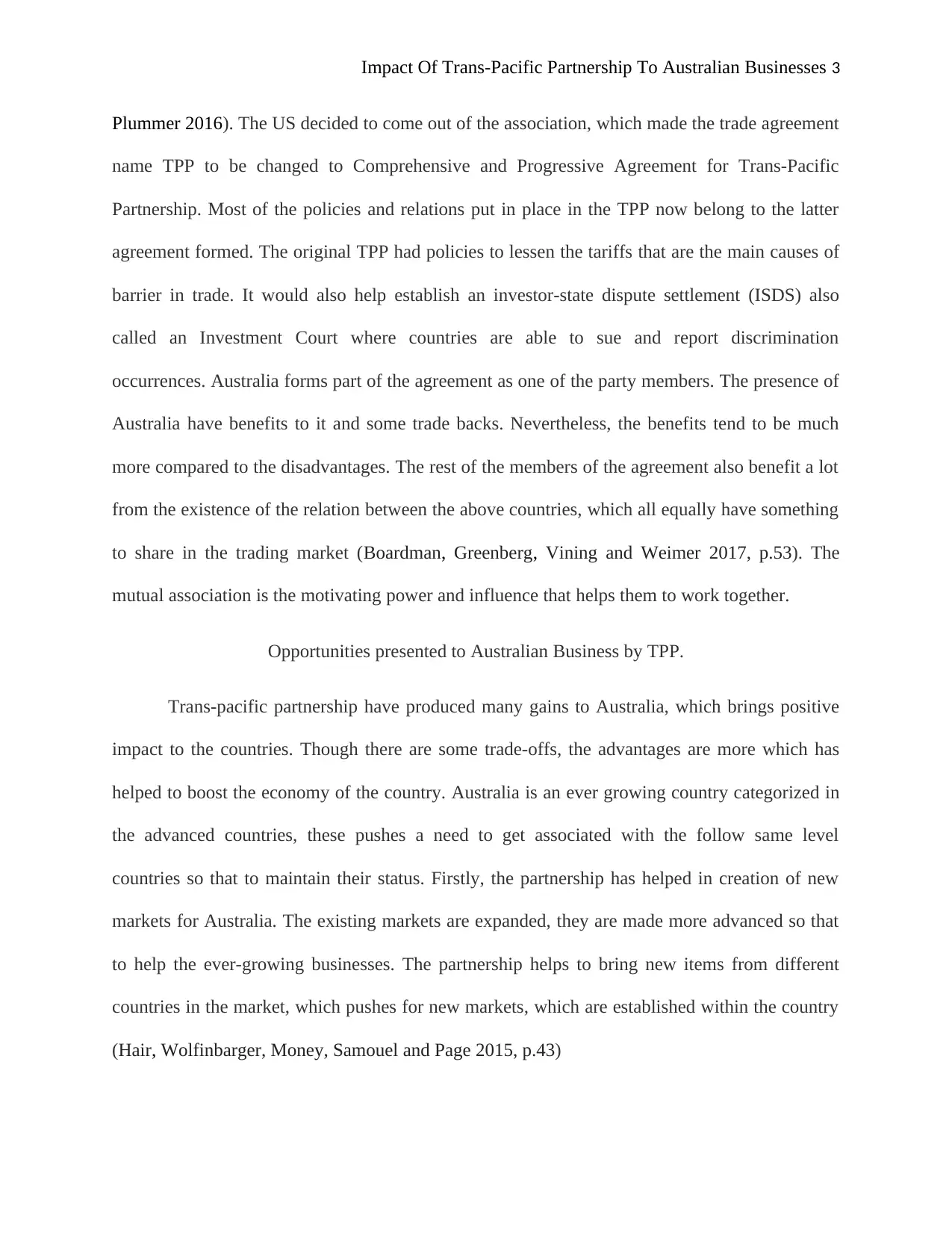
Impact Of Trans-Pacific Partnership To Australian Businesses 3
Plummer 2016). The US decided to come out of the association, which made the trade agreement
name TPP to be changed to Comprehensive and Progressive Agreement for Trans-Pacific
Partnership. Most of the policies and relations put in place in the TPP now belong to the latter
agreement formed. The original TPP had policies to lessen the tariffs that are the main causes of
barrier in trade. It would also help establish an investor-state dispute settlement (ISDS) also
called an Investment Court where countries are able to sue and report discrimination
occurrences. Australia forms part of the agreement as one of the party members. The presence of
Australia have benefits to it and some trade backs. Nevertheless, the benefits tend to be much
more compared to the disadvantages. The rest of the members of the agreement also benefit a lot
from the existence of the relation between the above countries, which all equally have something
to share in the trading market (Boardman, Greenberg, Vining and Weimer 2017, p.53). The
mutual association is the motivating power and influence that helps them to work together.
Opportunities presented to Australian Business by TPP.
Trans-pacific partnership have produced many gains to Australia, which brings positive
impact to the countries. Though there are some trade-offs, the advantages are more which has
helped to boost the economy of the country. Australia is an ever growing country categorized in
the advanced countries, these pushes a need to get associated with the follow same level
countries so that to maintain their status. Firstly, the partnership has helped in creation of new
markets for Australia. The existing markets are expanded, they are made more advanced so that
to help the ever-growing businesses. The partnership helps to bring new items from different
countries in the market, which pushes for new markets, which are established within the country
(Hair, Wolfinbarger, Money, Samouel and Page 2015, p.43)
Plummer 2016). The US decided to come out of the association, which made the trade agreement
name TPP to be changed to Comprehensive and Progressive Agreement for Trans-Pacific
Partnership. Most of the policies and relations put in place in the TPP now belong to the latter
agreement formed. The original TPP had policies to lessen the tariffs that are the main causes of
barrier in trade. It would also help establish an investor-state dispute settlement (ISDS) also
called an Investment Court where countries are able to sue and report discrimination
occurrences. Australia forms part of the agreement as one of the party members. The presence of
Australia have benefits to it and some trade backs. Nevertheless, the benefits tend to be much
more compared to the disadvantages. The rest of the members of the agreement also benefit a lot
from the existence of the relation between the above countries, which all equally have something
to share in the trading market (Boardman, Greenberg, Vining and Weimer 2017, p.53). The
mutual association is the motivating power and influence that helps them to work together.
Opportunities presented to Australian Business by TPP.
Trans-pacific partnership have produced many gains to Australia, which brings positive
impact to the countries. Though there are some trade-offs, the advantages are more which has
helped to boost the economy of the country. Australia is an ever growing country categorized in
the advanced countries, these pushes a need to get associated with the follow same level
countries so that to maintain their status. Firstly, the partnership has helped in creation of new
markets for Australia. The existing markets are expanded, they are made more advanced so that
to help the ever-growing businesses. The partnership helps to bring new items from different
countries in the market, which pushes for new markets, which are established within the country
(Hair, Wolfinbarger, Money, Samouel and Page 2015, p.43)
⊘ This is a preview!⊘
Do you want full access?
Subscribe today to unlock all pages.

Trusted by 1+ million students worldwide
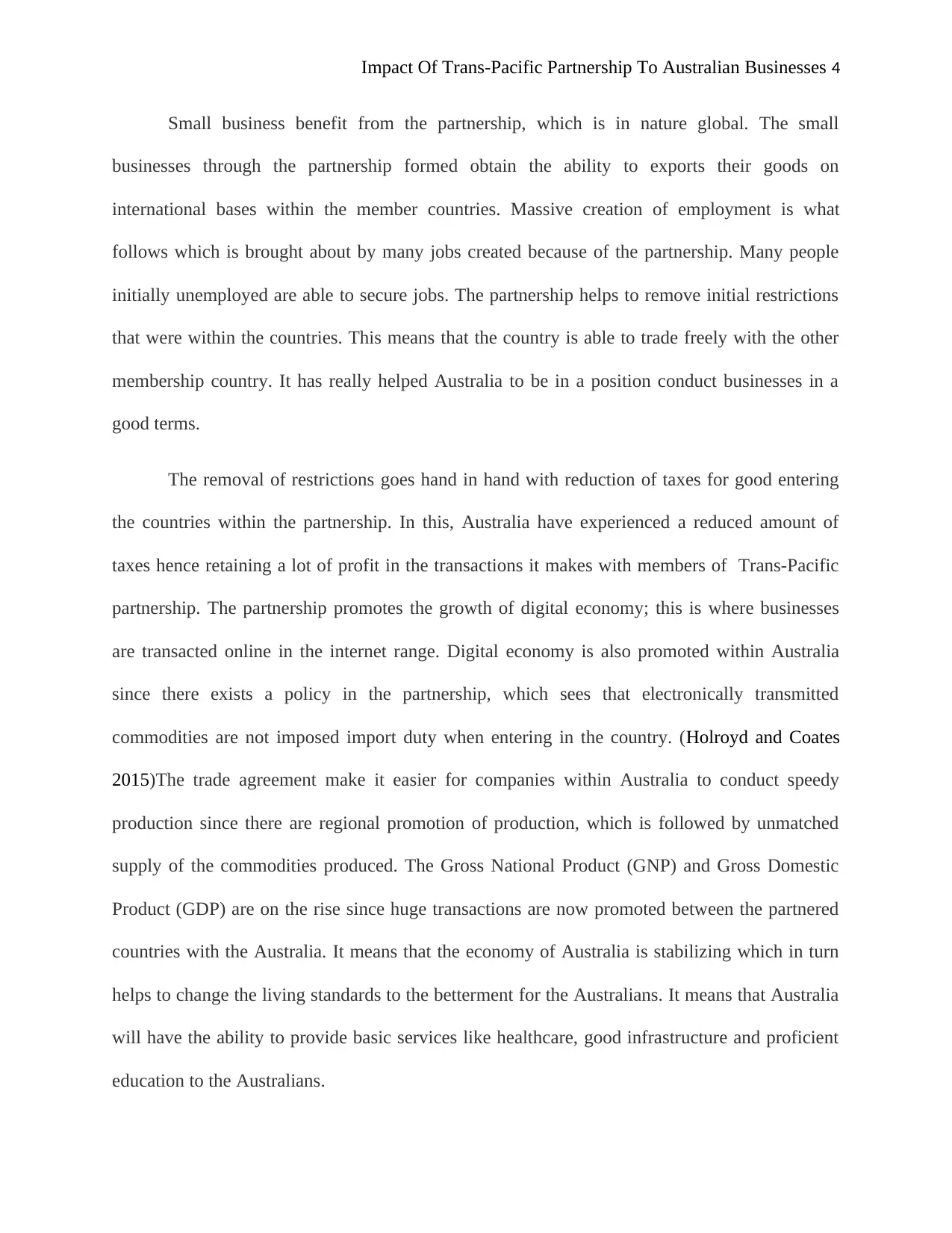
Impact Of Trans-Pacific Partnership To Australian Businesses 4
Small business benefit from the partnership, which is in nature global. The small
businesses through the partnership formed obtain the ability to exports their goods on
international bases within the member countries. Massive creation of employment is what
follows which is brought about by many jobs created because of the partnership. Many people
initially unemployed are able to secure jobs. The partnership helps to remove initial restrictions
that were within the countries. This means that the country is able to trade freely with the other
membership country. It has really helped Australia to be in a position conduct businesses in a
good terms.
The removal of restrictions goes hand in hand with reduction of taxes for good entering
the countries within the partnership. In this, Australia have experienced a reduced amount of
taxes hence retaining a lot of profit in the transactions it makes with members of Trans-Pacific
partnership. The partnership promotes the growth of digital economy; this is where businesses
are transacted online in the internet range. Digital economy is also promoted within Australia
since there exists a policy in the partnership, which sees that electronically transmitted
commodities are not imposed import duty when entering in the country. (Holroyd and Coates
2015)The trade agreement make it easier for companies within Australia to conduct speedy
production since there are regional promotion of production, which is followed by unmatched
supply of the commodities produced. The Gross National Product (GNP) and Gross Domestic
Product (GDP) are on the rise since huge transactions are now promoted between the partnered
countries with the Australia. It means that the economy of Australia is stabilizing which in turn
helps to change the living standards to the betterment for the Australians. It means that Australia
will have the ability to provide basic services like healthcare, good infrastructure and proficient
education to the Australians.
Small business benefit from the partnership, which is in nature global. The small
businesses through the partnership formed obtain the ability to exports their goods on
international bases within the member countries. Massive creation of employment is what
follows which is brought about by many jobs created because of the partnership. Many people
initially unemployed are able to secure jobs. The partnership helps to remove initial restrictions
that were within the countries. This means that the country is able to trade freely with the other
membership country. It has really helped Australia to be in a position conduct businesses in a
good terms.
The removal of restrictions goes hand in hand with reduction of taxes for good entering
the countries within the partnership. In this, Australia have experienced a reduced amount of
taxes hence retaining a lot of profit in the transactions it makes with members of Trans-Pacific
partnership. The partnership promotes the growth of digital economy; this is where businesses
are transacted online in the internet range. Digital economy is also promoted within Australia
since there exists a policy in the partnership, which sees that electronically transmitted
commodities are not imposed import duty when entering in the country. (Holroyd and Coates
2015)The trade agreement make it easier for companies within Australia to conduct speedy
production since there are regional promotion of production, which is followed by unmatched
supply of the commodities produced. The Gross National Product (GNP) and Gross Domestic
Product (GDP) are on the rise since huge transactions are now promoted between the partnered
countries with the Australia. It means that the economy of Australia is stabilizing which in turn
helps to change the living standards to the betterment for the Australians. It means that Australia
will have the ability to provide basic services like healthcare, good infrastructure and proficient
education to the Australians.
Paraphrase This Document
Need a fresh take? Get an instant paraphrase of this document with our AI Paraphraser
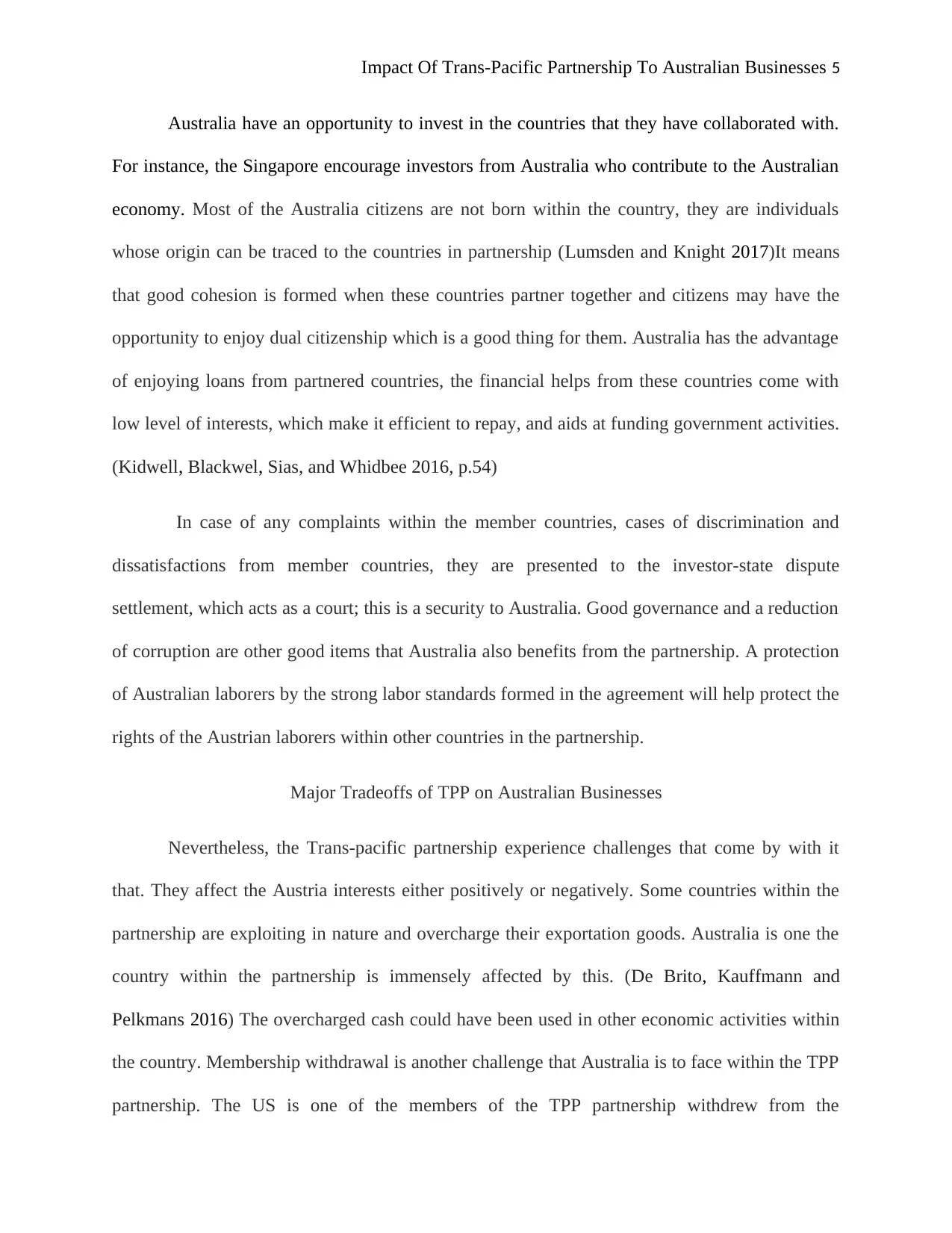
Impact Of Trans-Pacific Partnership To Australian Businesses 5
Australia have an opportunity to invest in the countries that they have collaborated with.
For instance, the Singapore encourage investors from Australia who contribute to the Australian
economy. Most of the Australia citizens are not born within the country, they are individuals
whose origin can be traced to the countries in partnership (Lumsden and Knight 2017)It means
that good cohesion is formed when these countries partner together and citizens may have the
opportunity to enjoy dual citizenship which is a good thing for them. Australia has the advantage
of enjoying loans from partnered countries, the financial helps from these countries come with
low level of interests, which make it efficient to repay, and aids at funding government activities.
(Kidwell, Blackwel, Sias, and Whidbee 2016, p.54)
In case of any complaints within the member countries, cases of discrimination and
dissatisfactions from member countries, they are presented to the investor-state dispute
settlement, which acts as a court; this is a security to Australia. Good governance and a reduction
of corruption are other good items that Australia also benefits from the partnership. A protection
of Australian laborers by the strong labor standards formed in the agreement will help protect the
rights of the Austrian laborers within other countries in the partnership.
Major Tradeoffs of TPP on Australian Businesses
Nevertheless, the Trans-pacific partnership experience challenges that come by with it
that. They affect the Austria interests either positively or negatively. Some countries within the
partnership are exploiting in nature and overcharge their exportation goods. Australia is one the
country within the partnership is immensely affected by this. (De Brito, Kauffmann and
Pelkmans 2016) The overcharged cash could have been used in other economic activities within
the country. Membership withdrawal is another challenge that Australia is to face within the TPP
partnership. The US is one of the members of the TPP partnership withdrew from the
Australia have an opportunity to invest in the countries that they have collaborated with.
For instance, the Singapore encourage investors from Australia who contribute to the Australian
economy. Most of the Australia citizens are not born within the country, they are individuals
whose origin can be traced to the countries in partnership (Lumsden and Knight 2017)It means
that good cohesion is formed when these countries partner together and citizens may have the
opportunity to enjoy dual citizenship which is a good thing for them. Australia has the advantage
of enjoying loans from partnered countries, the financial helps from these countries come with
low level of interests, which make it efficient to repay, and aids at funding government activities.
(Kidwell, Blackwel, Sias, and Whidbee 2016, p.54)
In case of any complaints within the member countries, cases of discrimination and
dissatisfactions from member countries, they are presented to the investor-state dispute
settlement, which acts as a court; this is a security to Australia. Good governance and a reduction
of corruption are other good items that Australia also benefits from the partnership. A protection
of Australian laborers by the strong labor standards formed in the agreement will help protect the
rights of the Austrian laborers within other countries in the partnership.
Major Tradeoffs of TPP on Australian Businesses
Nevertheless, the Trans-pacific partnership experience challenges that come by with it
that. They affect the Austria interests either positively or negatively. Some countries within the
partnership are exploiting in nature and overcharge their exportation goods. Australia is one the
country within the partnership is immensely affected by this. (De Brito, Kauffmann and
Pelkmans 2016) The overcharged cash could have been used in other economic activities within
the country. Membership withdrawal is another challenge that Australia is to face within the TPP
partnership. The US is one of the members of the TPP partnership withdrew from the
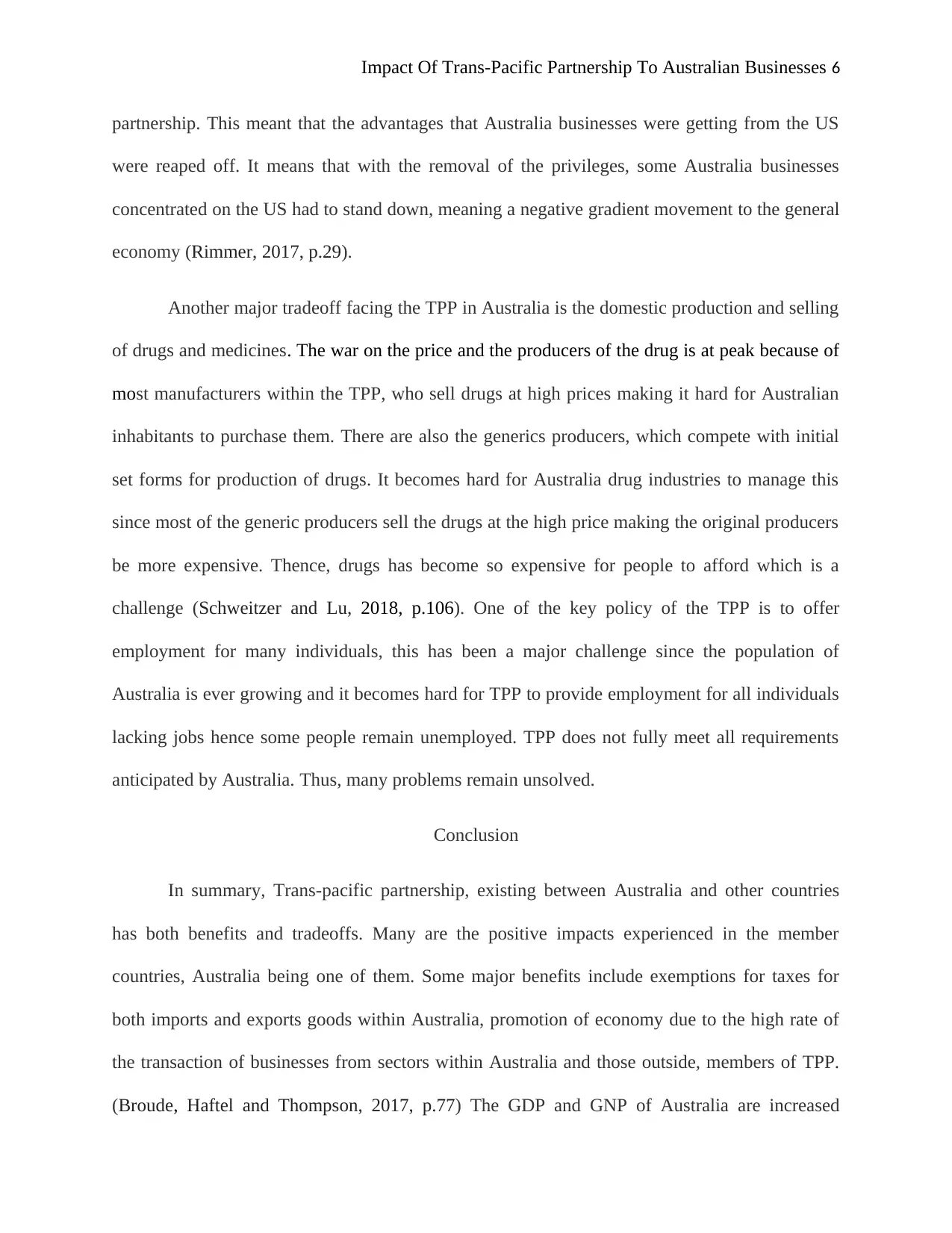
Impact Of Trans-Pacific Partnership To Australian Businesses 6
partnership. This meant that the advantages that Australia businesses were getting from the US
were reaped off. It means that with the removal of the privileges, some Australia businesses
concentrated on the US had to stand down, meaning a negative gradient movement to the general
economy (Rimmer, 2017, p.29).
Another major tradeoff facing the TPP in Australia is the domestic production and selling
of drugs and medicines. The war on the price and the producers of the drug is at peak because of
most manufacturers within the TPP, who sell drugs at high prices making it hard for Australian
inhabitants to purchase them. There are also the generics producers, which compete with initial
set forms for production of drugs. It becomes hard for Australia drug industries to manage this
since most of the generic producers sell the drugs at the high price making the original producers
be more expensive. Thence, drugs has become so expensive for people to afford which is a
challenge (Schweitzer and Lu, 2018, p.106). One of the key policy of the TPP is to offer
employment for many individuals, this has been a major challenge since the population of
Australia is ever growing and it becomes hard for TPP to provide employment for all individuals
lacking jobs hence some people remain unemployed. TPP does not fully meet all requirements
anticipated by Australia. Thus, many problems remain unsolved.
Conclusion
In summary, Trans-pacific partnership, existing between Australia and other countries
has both benefits and tradeoffs. Many are the positive impacts experienced in the member
countries, Australia being one of them. Some major benefits include exemptions for taxes for
both imports and exports goods within Australia, promotion of economy due to the high rate of
the transaction of businesses from sectors within Australia and those outside, members of TPP.
(Broude, Haftel and Thompson, 2017, p.77) The GDP and GNP of Australia are increased
partnership. This meant that the advantages that Australia businesses were getting from the US
were reaped off. It means that with the removal of the privileges, some Australia businesses
concentrated on the US had to stand down, meaning a negative gradient movement to the general
economy (Rimmer, 2017, p.29).
Another major tradeoff facing the TPP in Australia is the domestic production and selling
of drugs and medicines. The war on the price and the producers of the drug is at peak because of
most manufacturers within the TPP, who sell drugs at high prices making it hard for Australian
inhabitants to purchase them. There are also the generics producers, which compete with initial
set forms for production of drugs. It becomes hard for Australia drug industries to manage this
since most of the generic producers sell the drugs at the high price making the original producers
be more expensive. Thence, drugs has become so expensive for people to afford which is a
challenge (Schweitzer and Lu, 2018, p.106). One of the key policy of the TPP is to offer
employment for many individuals, this has been a major challenge since the population of
Australia is ever growing and it becomes hard for TPP to provide employment for all individuals
lacking jobs hence some people remain unemployed. TPP does not fully meet all requirements
anticipated by Australia. Thus, many problems remain unsolved.
Conclusion
In summary, Trans-pacific partnership, existing between Australia and other countries
has both benefits and tradeoffs. Many are the positive impacts experienced in the member
countries, Australia being one of them. Some major benefits include exemptions for taxes for
both imports and exports goods within Australia, promotion of economy due to the high rate of
the transaction of businesses from sectors within Australia and those outside, members of TPP.
(Broude, Haftel and Thompson, 2017, p.77) The GDP and GNP of Australia are increased
⊘ This is a preview!⊘
Do you want full access?
Subscribe today to unlock all pages.

Trusted by 1+ million students worldwide
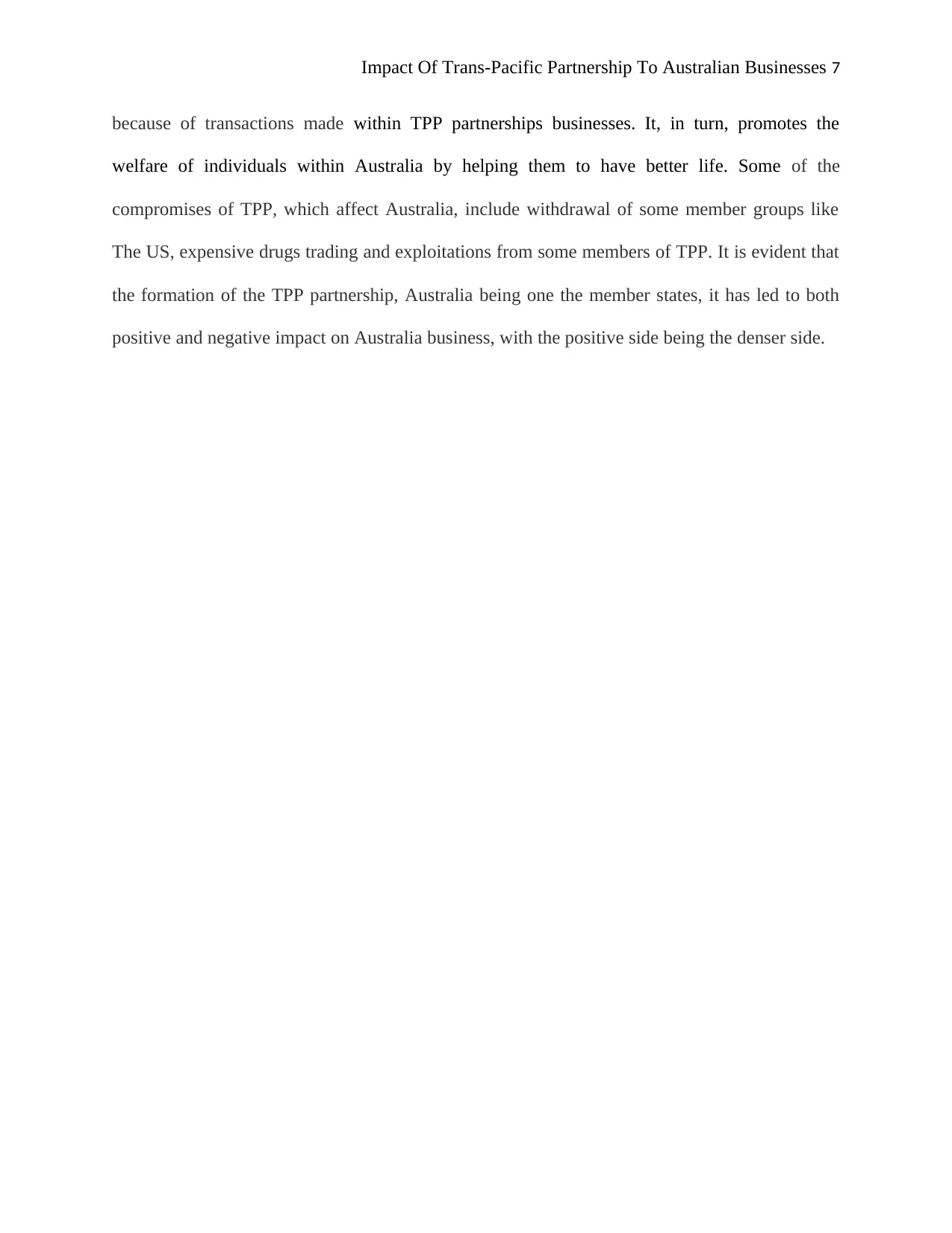
Impact Of Trans-Pacific Partnership To Australian Businesses 7
because of transactions made within TPP partnerships businesses. It, in turn, promotes the
welfare of individuals within Australia by helping them to have better life. Some of the
compromises of TPP, which affect Australia, include withdrawal of some member groups like
The US, expensive drugs trading and exploitations from some members of TPP. It is evident that
the formation of the TPP partnership, Australia being one the member states, it has led to both
positive and negative impact on Australia business, with the positive side being the denser side.
because of transactions made within TPP partnerships businesses. It, in turn, promotes the
welfare of individuals within Australia by helping them to have better life. Some of the
compromises of TPP, which affect Australia, include withdrawal of some member groups like
The US, expensive drugs trading and exploitations from some members of TPP. It is evident that
the formation of the TPP partnership, Australia being one the member states, it has led to both
positive and negative impact on Australia business, with the positive side being the denser side.
Paraphrase This Document
Need a fresh take? Get an instant paraphrase of this document with our AI Paraphraser
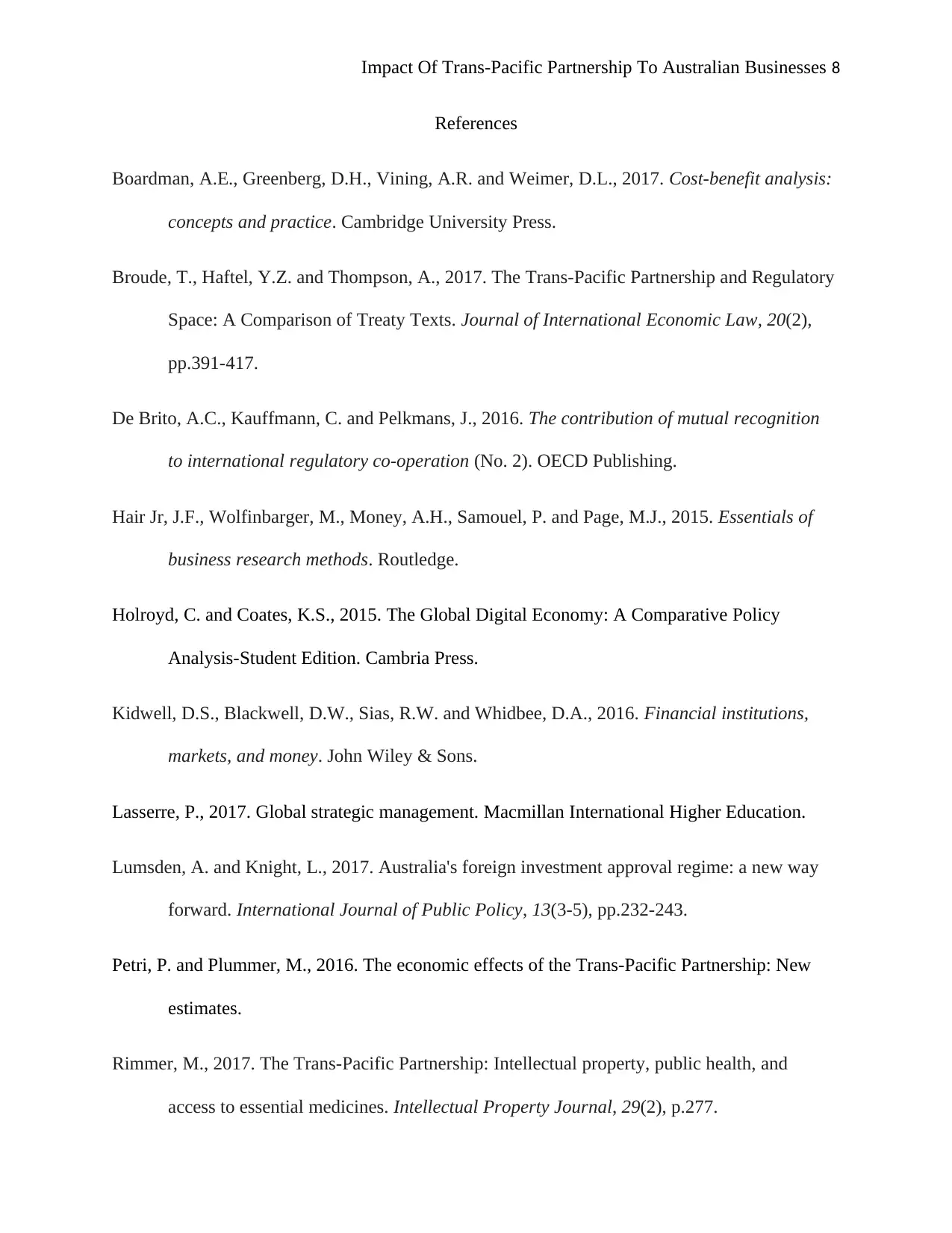
Impact Of Trans-Pacific Partnership To Australian Businesses 8
References
Boardman, A.E., Greenberg, D.H., Vining, A.R. and Weimer, D.L., 2017. Cost-benefit analysis:
concepts and practice. Cambridge University Press.
Broude, T., Haftel, Y.Z. and Thompson, A., 2017. The Trans-Pacific Partnership and Regulatory
Space: A Comparison of Treaty Texts. Journal of International Economic Law, 20(2),
pp.391-417.
De Brito, A.C., Kauffmann, C. and Pelkmans, J., 2016. The contribution of mutual recognition
to international regulatory co-operation (No. 2). OECD Publishing.
Hair Jr, J.F., Wolfinbarger, M., Money, A.H., Samouel, P. and Page, M.J., 2015. Essentials of
business research methods. Routledge.
Holroyd, C. and Coates, K.S., 2015. The Global Digital Economy: A Comparative Policy
Analysis-Student Edition. Cambria Press.
Kidwell, D.S., Blackwell, D.W., Sias, R.W. and Whidbee, D.A., 2016. Financial institutions,
markets, and money. John Wiley & Sons.
Lasserre, P., 2017. Global strategic management. Macmillan International Higher Education.
Lumsden, A. and Knight, L., 2017. Australia's foreign investment approval regime: a new way
forward. International Journal of Public Policy, 13(3-5), pp.232-243.
Petri, P. and Plummer, M., 2016. The economic effects of the Trans-Pacific Partnership: New
estimates.
Rimmer, M., 2017. The Trans-Pacific Partnership: Intellectual property, public health, and
access to essential medicines. Intellectual Property Journal, 29(2), p.277.
References
Boardman, A.E., Greenberg, D.H., Vining, A.R. and Weimer, D.L., 2017. Cost-benefit analysis:
concepts and practice. Cambridge University Press.
Broude, T., Haftel, Y.Z. and Thompson, A., 2017. The Trans-Pacific Partnership and Regulatory
Space: A Comparison of Treaty Texts. Journal of International Economic Law, 20(2),
pp.391-417.
De Brito, A.C., Kauffmann, C. and Pelkmans, J., 2016. The contribution of mutual recognition
to international regulatory co-operation (No. 2). OECD Publishing.
Hair Jr, J.F., Wolfinbarger, M., Money, A.H., Samouel, P. and Page, M.J., 2015. Essentials of
business research methods. Routledge.
Holroyd, C. and Coates, K.S., 2015. The Global Digital Economy: A Comparative Policy
Analysis-Student Edition. Cambria Press.
Kidwell, D.S., Blackwell, D.W., Sias, R.W. and Whidbee, D.A., 2016. Financial institutions,
markets, and money. John Wiley & Sons.
Lasserre, P., 2017. Global strategic management. Macmillan International Higher Education.
Lumsden, A. and Knight, L., 2017. Australia's foreign investment approval regime: a new way
forward. International Journal of Public Policy, 13(3-5), pp.232-243.
Petri, P. and Plummer, M., 2016. The economic effects of the Trans-Pacific Partnership: New
estimates.
Rimmer, M., 2017. The Trans-Pacific Partnership: Intellectual property, public health, and
access to essential medicines. Intellectual Property Journal, 29(2), p.277.

Impact Of Trans-Pacific Partnership To Australian Businesses 9
Schweitzer, S.O. and Lu, Z.J., 2018. Pharmaceutical Economics and Policy: Perspectives,
Promises, and Problems. Oxford University Press.
Shenkar, O., Luo, Y. and Chi, T., 2014. International business. Routledge.
Schweitzer, S.O. and Lu, Z.J., 2018. Pharmaceutical Economics and Policy: Perspectives,
Promises, and Problems. Oxford University Press.
Shenkar, O., Luo, Y. and Chi, T., 2014. International business. Routledge.
⊘ This is a preview!⊘
Do you want full access?
Subscribe today to unlock all pages.

Trusted by 1+ million students worldwide
1 out of 9
Related Documents
Your All-in-One AI-Powered Toolkit for Academic Success.
+13062052269
info@desklib.com
Available 24*7 on WhatsApp / Email
![[object Object]](/_next/static/media/star-bottom.7253800d.svg)
Unlock your academic potential
Copyright © 2020–2025 A2Z Services. All Rights Reserved. Developed and managed by ZUCOL.




